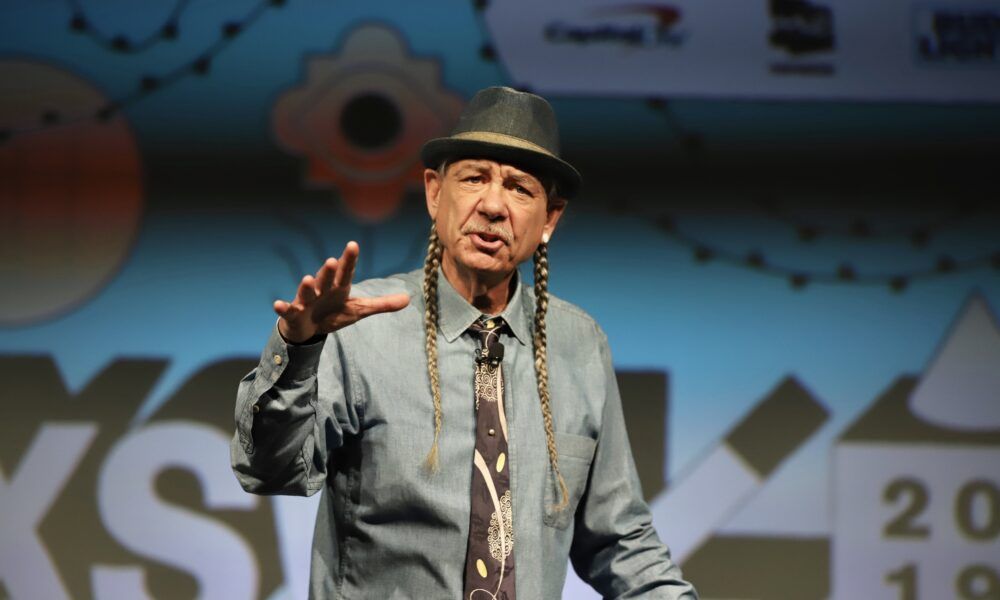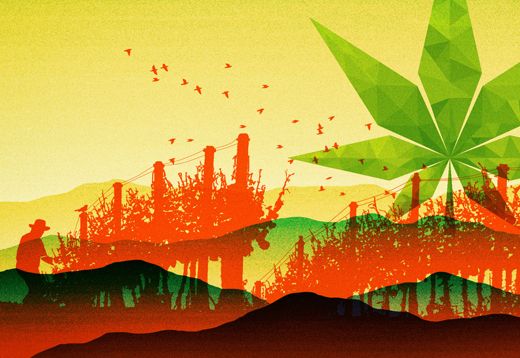The Father of the Legal Cannabis Industry
Cannabis activist and pioneer Steve DeAngelo discusses how hemp can literally save the world, about its likelihood as an industry disrupter, and what cannabis legalization may look like under President Biden.
Don’t at all be fooled by his mellow demeanor or by his trademark pigtail braids and pork pie hat, because Steve DeAngelo is all business. A pioneering activist for the cannabis reform movement, Mr. DeAngelo has dedicated his life to advocating the cannabis plant first and foremost as a connoisseur, but also as an author, educator, investor and entrepreneur.
He is credited with co-founding Harborside in 2006 as a nonprofit medical cannabis dispensary, when the company was granted one of the first medical licenses in the country. His other achievements are quite impressive: the Discovery Channel miniseries Weed Wars; he was the lead organizer and fundraiser for I-59, Washington D.C.’s medical cannabis initiative; also, Mr. DeAngelo, who studied at the University of Maryland School of Law, successfully litigated against the Department of Justice’s last-ditch effort in 2011 to shut down California’s medical cannabis dispensaries; and he also played a major role in the passage of Prop 64, which legalized recreational cannabis for adults in California.
The Texas Hemp Reporter caught up with the legend himself earlier this year, not long after he parted ways with Harborside Inc, a California-focused cannabis enterprise that is currently a publicly listed company on the Canadian Securities Exchange, where he was co-founder and, most recently, chairman emeritus.
TEXAS HEMP REPORTER: Is the legalization of cannabis on the federal level likely to happen during the Biden presidency?
STEVE DeANGELO: We are likely to see some significant reform at the federal level. I’m not sure that’s going to include what we would call complete legalization. President Biden and Vice-President Harris have a long history of working with law enforcement. They both have a record ‒ not a good record ‒ of passing and enforcing laws that really hurt a lot of people. Kamala Harris, when she was the attorney general of California, oversaw many, many, many cannabis prosecutions. There are still people in prison today because of her prosecutions for something that is legal now. And after she was elected with a lot of the help from the [medical] cannabis industry, she failed to come to our assistance in 2011 when the federal government tried to shut down the California industry. In fact, in a TV interview, she basically laughed about the idea of cannabis reform. So, with that said, I think both Biden and Harris are creatures of a political center. That’s where they want to position themselves; and now the whole Democratic Party is in favor of cannabis ‒ as well as a big chunk of the Republican Party. And, really, cannabis is the only bipartisan consensus issue between the two parties today. Sixty percent of Americans are in favor of legalization. So I do have faith that Biden and Harris will figure out where the political center is on on this, and the more help we give them to do that, the sooner we’ll see reforms and the more likely they’ll be complete.
THR: Now that you’ve cut ties with Harborside, what’s going to be your biggest focus going forward?
SD: I’m really interested in the ESG space, which to some means “Equity, Sustainability, and Governance.” Some people call it “Environmental, Social, and Governance.” There’s a whole sector of investors for whom the whole sector of ESG investing is a growing and increasingly important sector ‒ probably the most rapidly-growing investor sector today. And on the company side, we have many cannabis companies that are going to be headed up by licensees who receive social-equity licenses. And those licenses frequently have a really difficult time finding financial resources that they need to develop their licenses. So that’s a problem I would really like to help solve, and I think there’s a win-win solution there for equity licensees and for investors who are interested in making an impact.
THR: Of course you’ll be focusing on the Last Prisoner Project, too. Tell us, essentially, what the nonprofit is fighting for.
SD: The mission of the Last Prisoner Project is really narrow. We hope someday to put ourselves out of business. Its mission is simple: And that’s to make sure that, as this new, global, legal cannabis industry is built, every single person on the planet who’s imprisoned on cannabis charges is released. It comes out of a basic notion of fairness. We shouldn’t keep punishing people for it. In today’s atmosphere, it’s just completely unacceptable for white guys with Ivy-League degrees working on Wall Street to come into legal cannabis and get licenses and grow and sell tons and tons of cannabis at the same time that there’s mostly black and brown people who are imprisoned for cannabis crimes involving far, far smaller quantities. Eighty-seven percent of cannabis prisoners in the federal system are people of color. Our mission is really focused on cannabis prisoners; it becomes a social-justice mission just by virtue of the fact that so much of the prohibition in the United States is racially driven. … What we do is work for the release of prisoners, and then we also work to make their reentry [into society] productive and fruitful.
THR: On your website is a very compelling, convincing video of you saying how hemp can save the world, how it could replace all the materials that are sickening us as well as the planet. Can you expound on this?

SD: For me, it’s all one plant. There’s this unfortunate confusion of terminology that’s come into place, largely because there’s a loophole under hemp regulation to allow ‘hemp to be grown for human consumption’ as long as it doesn’t contain THC. I think that’s really the wrong way of looking at it. For me, there’s just two kinds of cannabis: cannabis that is produced for human beings to consume, whatever its cannabinoid and terpene profile is; and cannabis that’s produced to make something out of. I don’t muddy those definitions up with THC, because THC is just one of 140 different cannabinoids that prohibition has an obsession with. But that doesn’t mean that we should. I absolutely see industrial hemp as being a critical part of the revolution that’s underway here. Mother Nature was incredibly kind to us. She gave us one plant that wakes up our minds and brings us closer in touch with nature, and at the same time gives us the raw materials that we need to build the new economy, a life-affirming economy. Part of it is raising the consciousness with cannabis, and part of it is just the raw material. Hemp is such an extraordinary raw material. Not only can you make everything and anything out of it the way you could with petroleum, trees or cotton; there’s all these other amazing things you can make out of hemp that you can’t make out of petroleum, trees or cotton, like graphene. There’s a company now that’s making hemp graphene, a semiconductor critical in making cell phones. It’s currently mined in Africa at an extraordinary cost, both financial and social. And now a company has figured out how to make it out of hemp. They’re talking of making houses and airplanes and cars out of hemp graphene. The whole outer parts of our buildings and our cars, maybe even our clothing, could be solar-collection devices. Let me be clear: I’m not talking about CBD. I’m not talking about consumable cannabis. That for me is a different conversation. When we look at industrial hemp in the United States, it is underdeveloped for one major reason, and that is because there is no infrastructure in existence to make sure the hemp crop is turned into the products that the market wants. I’ll give you one example. One of the greatest uses for hemp is in textiles. You can make these absolutely super high-quality textiles out of hemp. You can blend them with cotton, you can make it 100 percent hemp. Levi’s right now is making a jean that is 30 percent hemp fibers and 70 percent cotton. They would like to increase the amount of hemp in there. But the hemp fibers, they’ve had to cottonize them. This is an example of infrastructure. Hemp is the longest, strongest natural fiber on the planet, but because cotton has been such a dominant textile fiber in the United States for so long, we don’t have bast-fiber spineries. We don’t have a way to turn hemp fiber into a hemp yarn without doing what Levi’s is doing, which is basically blowing it up and making it into very, very short, and hence very weak, fiber, rather than trying to take advantage of the full qualities of hemp. Just because the infrastructure is not there. So once we have a sufficient commitment of vision and capital to build that infrastructure, then we’re going to see hemp disrupt every single kind of industry you can imagine. Just about anything that is made, hemp is going to disrupt. Because it’s such a great raw material when done at scale. Anything you can make out of other raw materials can be made out of hemp and it’s usually a much higher-quality product and no more expensive. Then there’s all these things that hemp does that nothing else does. Hemp sequesters 20 tons of atmospheric carbon for every hectare that you harvest. That means that we could stop Global Warming just by planting enough hectares of hemp and harvesting them. And then it makes really simple products like hempcrete, a remarkable material that is as strong as concrete, lighter than concrete, more mold-resistant, more fire-resistant, and less expensive, and not only carbon-neutral but carbon-negative. The hempcrete also sequesters carbon as it dries. Hempcrete is probably the place where we have the least infrastructure problem. I would say that the construction-materials sector is probably the place where we will see the disruption of existing industries by hemp in the shortest period of time in North America, because you don’t really need the complicated infrastructure to produce and use something that most builders can use on the building site.
THR: It’s been a pleasure, Mr. DeAngelo. Good luck to you and thank you for all you do for hemp and cannabis.
SD: Thank you so much. Be well.






